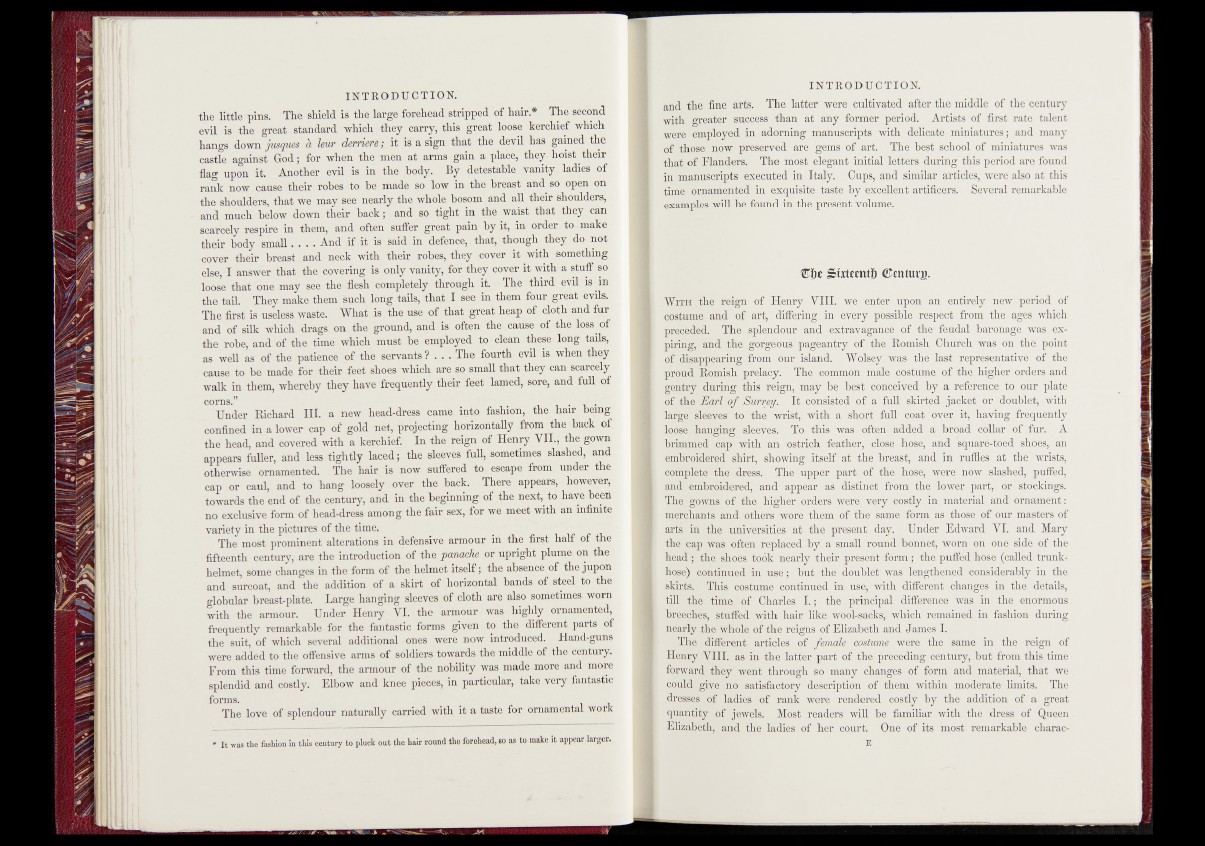
i n t r o d u c t i o n ;
the little pins. The shield is the large forehead stripped of hair.* The second
e-vil is the- great standard 'whiahUhey carry, this great loose kerchief which
hangs down jusques h leur demere; it is a sign that thé devil has gained the
castle against God j for when the rmen at arms gain a place, jhe^.hoist-their
flag upon it. Another evil is,in the body. By detestable; vanity, ladies' of
rank now- cause their robes to be made so low in the breast , and so open on
the shoulders, that We may see nearly the whole bosom and all-|hbii Shoulders,
and much below down their back; and so tight in the .waist, that, they can
scarcely respire in them, 'and often suffer great pain by-it, in order- to-make
their bódy small. . . . And if it is said in defence, that, though
coyeiMheir breast „and neck with their robes, they-$ovef-it with ^something
I answer that the. covering-is only vanityyf4tthey cover-it with-a;^tiff So
-loose that one may see the flesh completely through i t - The third.e^Vus in
the tail They make them such long tails, that I see\dn them four great .evils.
The first is useless, waste. What is the use of that great heap of-‘cloth-and
and of silk which drags on,the ground, and is often the „cause f,of: thé
the robe, ahdtof the time which must be employed, to clean; tiae»e4on| ;tail$
as well as of the patience of the se rv a n ts^ , CMeJbqrth^va^is w b e n ^ e j
cause to be made forjtheir-feet shoes which are so small that5|hey.Jc:m scarSelj
walk in them, whereby they have frequently their'feef lamed?ïsore,, and-fifllyof
corns.”' " " -- --“"•y4*
pader Richard III. a new head-dress 'came, intp fashion, the hair
confined in. a lower cap of gold net, projecting horizontally,ÏEoni. .|febaék-,of
the head, and covered with a kerchief. In the.'ragh .the-gown
appears fufler, and less tightly laced ;_the.sleeves full,sometimes slashed, and
otherwise omamented. The hair is now suffered to. escape from, under the
cap or caul, , and to hang loosely -over the .back There appears, bpw-eyer*
towards the end of the century, afld in the beginning of- the next,, to Rave been
no exclusive form of head-dress among the fair sex, for we-meet with an infinite
variety in the pictures of the time. • ■ • ; _ V
The moBt prominent alterations in defensive armour the first half of the
fifteenth century, are the introduction of the panache ori upright plume on-the
helmet, some changes in the form of the helmet itself; the absence-of the jupon
and sureoat, and the addition of a skirt of horizontal bands .of. steel to the
globular breast-plate. Large hanging'sleeve», of cloth are also sometimes worn
with the armour. Under Henry YI. the armour was highly ornamented,
frequently remarkable for the fantastic forms given to the different parts of
the suit, of which several additional ones were now introduced., Hand-guns
were added to the offensive arms of soldiers towards the middle of the century.
From this timp, forward, the armour of the; nobility was made more and more
splendid and costly. Elbow and knee pieces, in particular, take very fantastic
forms. (
The love of splendour naturally carried with it a taste for ornamental work
* It was the in this century to pluck out the hair round the forehead, so as to make it appear larger».
and’ th^fine arts. The ^tte^were. bultivated'ia'fter "themiddle of the century
former period. Artists of first rate talent
Were gmjaknod inJadoming^mahu^criptB with delicate miniatures; and many
o fP lk n ow W - e rv e d are* "gems of^aiit!?” The best School of miniatures was
th »p ^ ^ S ^ B l^RfIihitial;ietters;during this period are found
iff^^^Mrripts 5gec&tga5 in ItaTySamuPiJajH L similar 'articles, were also at this
thnefc.anfanieiifo^ bs om ellent artificers. Several remarkable
esSMlfeK- ^ iiy.fefoiihdMroft^
Ch r g titten ti) ©ettiurg.
s1i ^ ;B I 8 r% '' ■ ■ we* an H h new period' of
ary differing in ®g®pp®hl?M%^t*t from^^»tee» which
nr^^g/l^gi^ ^ fl'endour» -and yf xtja^.aha « ^ o f • the • ff qrlal baronagfe was
mjjmf^ahd th e® ^ ^ $ ^ |'p !6i^Lalyti).^^^^™liomi-h ® u h ^a-. 01/ -tire point
pm ^ UTtearin <s ’ the last ^representati^^of the
prbu<f?Kdim>h prfJacy.* feme.eonuniujfemale:'(TOmg o|§ the higji&n orders and
dnnt^^ns^cigfl, may by a* to our plate
7 * ' rr' I iVf*■ Ti'i-m" full -'with
frequently^
lod'se haiioiiiff-isleeves. I TMi this broad colljr 5offur. A
hriimnpd jStp with an fosfnGh..feather, elo'^ ^§h\^anllfcS(piar(St^^®shocs, an
rmhTpjdcred^Hh't, "showing1 itself at w hua-.t, and.in ruffles/^Mth^wTists,
complete Spite rdress. TheSu|per part-'of th ^ ^ ^ ^ e MfhoW1 slashed.' nuffed.
atid^enulirgi(lcred, and* appea^^as distinct from^tHWlower^part, or stockings.
The^gbwns' of the higher orders wer(/"xcry4(;ostl\^S material and ornament:
merchants afid StHcr-5pQOre/them of the ^ameTorm as tliosi o0mi masters of.
a|ts,-in ».the universities -at-* the present day. - 1 nder Edward YI. and Mary
the-leap was often replaced by? a- small round bonnet, worn |psi|Be' side of the
head') th®.»Hoes took'nearly their pftspht form r xhe'ouffSjhdse, (called trunk-
hW&)j;v continued in use; hut the wa> dlpg'thmfed considerably in the
skirts-..rfhis.*'costume continue^-mjjpscv' with‘different in the details,
ti|l'^tlie time of Charles' I.; the principalf^li’fferejlco^ v as/in the enormous
.breeches, stuffed with hair like woOfcsapks, which remained; in' fashion during
ne&j^y.the'whole of the reigns of Elizabethand James Tims
The different articles of female-^pstume,'were- the same in the reign of
Hepry YIII. as in 'the latter part of'tap preceding, century,-but from this time
forward they went, thiough^ko many changes of Iform and material, that we
could give • no satisfactory 'description of than within moderate limits.' The
dresses of ladies of rank were rendered cos.tly .hy, the addition of a great
quantity of jewels. Most readers' will be familiar with the dress of Queen
Elizabeth, and ;ln| ladies of her court. Qhe^of' its most remarkable eharac